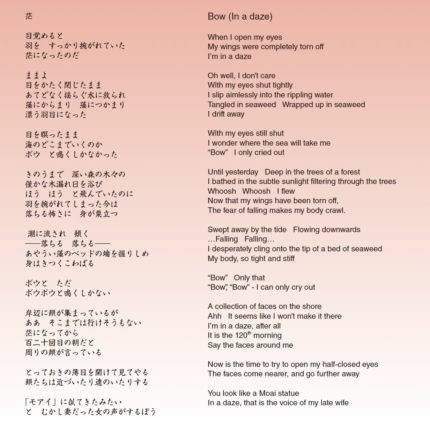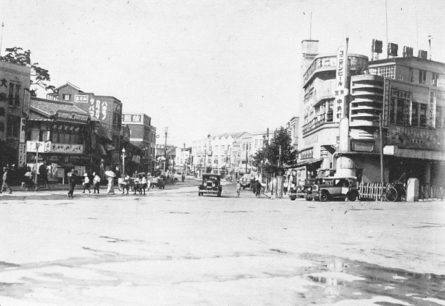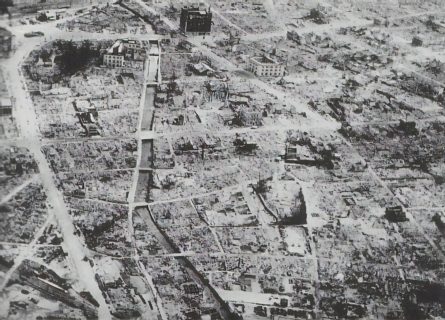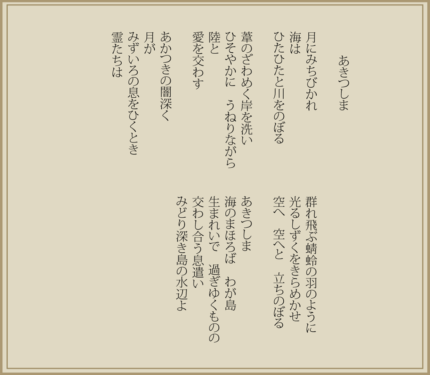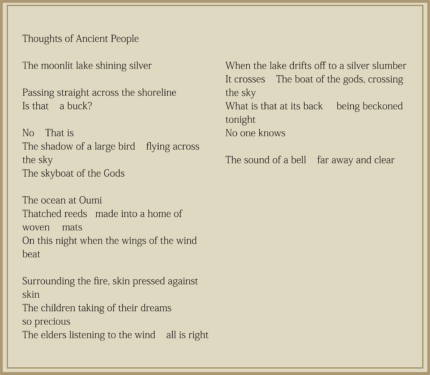- JEPAA Member

- Poet
- Atsuko Iketani
- 詩
- 池谷敦子
© 2024 Atsuko Iketani.
SCROLL
Portfolio /作品一覧
- 茫/Bow (In a daze)
- はぐれ凧/A Stray Kite
- ブリキの月/Tin Moon
view more
Art History /アートヒストリー
不穏な時代と自由
池谷敦子は、1929年静岡県浜松市に4人姉弟の1番目として生まれました。時は世界恐慌の真っ只中、後の太平洋戦争へと日本が突入していく前兆が漂っていた時代です。幼い敦子の目には、大人たちが戦争へと一辺倒に向かっているように見えていました。
故郷の浜松市は現在も続く工業地帯で、当時は軍事品の生産に注力していました。周囲には軍関係の施設も多数併設され、軍人たちが闊歩するのも見慣れた光景だったと言います。
池谷家はごく普通の一般家庭でしたが、広い座敷もあったため、時折将校らが宿泊に来るなど、おおよそ現代では考えられないような日常が広がっていました。
しかしそれは大人の話。子どもたちと言えば、世間からも、うるさい親の目からも解放されて、自由を満喫していたと言います。現代のようにきれいなショッピングモールも楽しい遊園地もありませんが、学習塾も受験もなく毎日子ども同士で日が暮れるまで遊んでいられる日常は、ある意味で現代よりも幸せだったと言えるでしょう。
敦子もその空気をしっかりと感じていたそうで、「勉強などで無理な競争をしなくてもよかった分、子どもたちはみんな仲が良かった」と回想しています。
戦争と学び、朗読、踊り
不安な世相を感じながらも自由を満喫した幼少期が過ぎ、敦子も小学校に入学します。しかし1939年に第二次世界大戦が勃発すると、日本は急速に戦時下の緊張した時代へと様変わりしました。
無論、敦子の青春も例外ではありません。女専に進学したのに、憧れのセーラー服に袖を通す間もなく、朝から晩までモンペ姿でお国のためにと働かされました。軍服修理に芋掘り、壕みぞ掘り、竹槍訓練。果ては学徒動員で工場に派遣され、訳もわからずベニヤ板で飛行機部品を作らされる始末です。
戦中・戦後という動乱の時代に青春を翻弄された敦子ですが、そんな日々の中にあって彼女の救いとなったのが踊りと朗読でした。
幼少期から踊りが好きだったと回顧する敦子ですが、その腕前は学生ながら異彩を放っていたと言います。実際、敦子は学生時代、同級生ら数人で浜松市周辺の舞台に呼ばれて大勢の観客を前に踊りを披露していました。
「踊りが上手い生徒5、6人で舞台に立っていましたね。とても楽しかったですよ。」
当時でも学生が複数のオファーを受けていたというのは異例の話であり、それほど彼女の踊りが素晴らしかったことを示す証と言えるでしょう。
一方の朗読は、幼少期には特別に意識するものではなかったようです。しかし、ある日の授業のことでした。敦子の朗読を聞いていた先生が、堪えきれずに涙をこぼしたのです。教科書から顔を上げた敦子は驚くばかりでしたが、この時から自分の朗読が他の人とは少し違うかもしれないと思うようになります。そして、漠然と自分の中にあった表現する喜びをはっきりと実感するようになっていったのです。
しかしそんな敦子を、更なる不幸が襲います。1945年6月、浜松の空を襲った米軍機B29約100機が市街地に向かって容赦ない爆撃を行なったのです。後に浜松大空襲と呼ばれるこの空襲により1万5,000余戸の家屋が全焼し、1,717人が命を落としました。当時の池谷家では、家族は山へ疎開し、軍需工場に通う敦子が1人で家を守っていました。その日の夜更け、轟音に目覚めた敦子は、「来た!」と飛び起き、防空壕目がけて逃げ込みました。しかし目の前の空はすでに赤く染まり、これは危ないとすぐに壕を飛び出します。敦子はそのまま天竜川沿いを北へ北へと逃げていきました。先程まで身を潜めていた濠は爆撃を受けて跡形も無くなってしまいます。16歳の彼女にとって、あまりにも過酷な一夜でした。
家も学校も失った敦子は、山村の納屋で命をつなぎます。8月には終戦となりましたが、ぼろを身にまとい、食べる物も乏しい有様でした。そんな苦しい状況の中にありながらも、彼女の中には、「勉強したい!」という強い思いが芽生えていました。そんな折、ある私塾で彼女の心を明るくしてくれる先生に出会います。敦子はこれまでも先生との巡り合わせが良く、小学校、女学校、専門学校で5人の先生と出会いましたが、いずれも彼女の長所を認めてくれていました。そんな日々の中で、敦子は「自分自身を認める」というまたとない恩恵を受けることができたのです。
詩との出会い、そして現在
- あきつしま
- Akitsushima
女子専門学校を無事卒業後、敦子は産婦人科の研修医だった夫と出会い、結婚します。しかし新婚生活は決して夢のようなものではありませんでした。わずか半年後に夫が生涯の病を発症し、さらに子どもにハンディキャップがあるとわかったのです。
敦子は、病院では経営を、家では家族を懸命に支え、危ない橋を渡る覚悟で苦境を乗り切ります。幸いにも夫婦仲は良く、夫も医師としての技術は確かでした。彼女の献身もあって病院は大きなミスもトラブルも発生することなく、無事に医業を終えることができました。天の救いだったのかもしれません。
そんな敦子に、詩という新たな喜びが生まれます。それは彼女にとって歌であり、祈りであり、誰かに届けたい想いでした。詩という新たな世界を知った敦子は、再び輝きを取り戻します。これまでの荒波多き半生の中に詩作の動機は散りばめられていました。
敦子の作る詩が評価を高めるのに、それほど時間はかかりませんでした。人生の荒波の中、深く深く潜るように深淵の世界へ誘う彼女の表現世界は、ごく自然で、そして人間の本質を捉えていると広く賞賛を受けています。
池谷敦子という1人の表現者が乗り越えてきた半生は、並大抵のものではありません。しかし様々な困難を切り抜けて来られたのは、自分を知り、認めることができたからなのでしょう。それが他人を大切に思い、気持ちを伝えることにつながったからに違いありません。
Uneasy Times and Freedom
Iketani Atsuko was born in Hamamatsu City, Shizuoka Prefecture in 1929 as the first of four children. At the time, Japan was in the midst of the Great Depression, and there were signs that the country was about to enter the Pacific War. In the eyes of the young Atsuko, the adults seemed to be heading single-mindedly towards war.
Her hometown of Hamamatsu was an industrial area and continues to be to this day. At the time the city was focused on the production of military goods.
There were also many military facilities in the area around Atsuko, and it was a familiar sight to see soldiers strutting around. It was a time completely inconceivable nowadays, when the Iketani family, a typical family but possessing a large tatami room, occasionally lodged officers.
But that is what it was like for the adults. As for the children, Atsuko says they were enjoying their freedom, free from the world and the eyes of their nagging parents. There were no beautiful shopping malls or entertaining amusement parks like today, but there were also no cram schools or entrance exams, and children could play together every day until nightfall, which in a sense made for a happier time than today.
Atsuko also had a firm feel for the mood of the time.She recalls, “All the children got along well because they didn’t have to compete with each other in their studies.”
Learning, Recitation, and Dancing During the War
After a childhood full of freedom despite the uncertainty of the world, Atsuko went on to higher education. However, with the outbreak of World War II in 1939, Japan rapidly changed into a tense wartime environment.
Of course, Atsuko’s youth was no exception. Even though she attended a girls’ school where she had the time of her life, she barely had time to enjoy her longed for sailor dress when she was forced to work for her country from morning to night in women’s work pants. She repaired military uniforms, dug potatoes, dug shelters, and trained with bamboo spears. Eventually, she was sent to a factory as part of the student mobilization program and was forced to make airplane parts out of plywood without understanding why.
Atsuko’s youth was bombarded by the turbulent years of the war and post-war years, but it was dance and recitation that helped her through those days.
Atsuko recalls that she has loved dancing since she was a child, and her skills were unique even as a student. In fact, when Atsuko was a student, she and several of her classmates were invited to dance on stages around Hamamatsu City in front of large audiences.
“You were on stage with fi ve or six students who were good dancers. It was a lot of fun.”It was unusual for a student to receive multiple off ers even at that time, and this is proof of the superior quality of her dancing.
Recitation, on the other hand, was not something hat Atsuko was particularly aware of in childhood. But something happened in class one day. The teacher, who was listening to Atsuko’s recitation, was unable to restrain herself and burst into tears. Atsuko looked up from her textbook surprised, but from this moment on she started to think that her recitation might be a little diff erent from that of other people. She began to have a clear realization of the joy of expression that had existed vaguely within her.
However, Atsuko was struck by a further misfortune. In June 1945, around 100 U.S. B-29s attacked the skies of Hamamatsu, bombing the city without mercy. This air raid, later called the Hamamatsu Air Raid, burned down more than 15,000 houses and took the lives of 1,717 people. At the time, the Iketani family had evacuated to the mountains, and Atsuko, who went to work at a munitions factory, was the sole keeper of the house.
Late that night, Atsuko was awakened by a roar. Realizing what had happened, she jumped up and ran for the air-raid shelter.
However, the sky in front of her was already turning red, and she immediately ran out of the shelter, thinking it dangerous. Atsuko fled farther and farther north along the Tenryu River. The shelter where she had been hiding earlier was bombed and no trace remained of it. It was a harsh night for the 16-year-old.
Atsuko lost her home and her school, and kept herself alive in a shed in a mountain village. The war ended in August, but Atsuko was clad in rags and had little to eat. In spite of this difficult situation, she had nurtured a strong desire to study within herself.
Then she met a good teacher at a private school who breathed inspiration into her. Atsuko had had good luck with teachers in the past. She had had five teachers between her elementary school, her girls’ school, and her vocational school, and all of them recognized her strengths. During this time, Atsuko received the unique blessing of “recognizing herself.”
Encounters with Poetry, and the Present
- いにしえびとをおもう
- Through of ancient people
After successfully graduating from women’s technical school, Atsuko met and married her husband, who was a general practitioner of obstetrics and gynecology. But her newly-wed life was not a dream come true. Only six months later, her husband developed a lifelong illness and she also found out that her child had a handicap.
Atsuko worked hard to support operations at the hospital and her family at home, and she overcame a difficult situation with the resolution of one crossing a dangerous bridge. Fortunately, the married couple got along well, and her husband was a skilled physician. Thanks to her dedication, the hospital was able to complete its medical operations without any major mistakes or problems. It was probably divine salvation that guided her.
Then Atsuko discovered a new joy: poetry. To her, poetry was a song, a prayer, a feeling she wished to convey truly. Having discovered this new world of poetry, Atsuko regained her radiance.
The motivation for Atsuko to compose poetry was scattered throughout her life, which has been one full of rough patches.It did not take long for the poems Atsuko created to grow in reputation. Her world of expression, which invites us to dive deep into the abyss of life’s stormy seas, has been widely praised for its naturalness and for capturing the essence of human nature.
The life that this one artist, Iketani Atsuko, has pulled herself through is not an ordinary one. However, she was perhaps able to overcome her many troubles because she was able to know and acknowledge herself. This must have led her to care for others and to express her feelings.
Art History /アートヒストリー
Vol.2
水と闇のものがたり
池谷敦子氏の作品に共通するのは、奥底に佇む別 世界の気配である。『夜明けのサヨナラ』ではそれ が海であり、『枇杷』では雨の日だ。序章と冠され た『わたしが居る場所』も、最初の1行から「野原 に雨が降っている」と切り出している。『水の音』では遮断された視界の中に別の世界が広がっており、 これもまた異界の一つである。また『雪ふる運河』 も北国に住んでいない人々にとっては非現実な空間 だろう。 池谷氏が優れているのは、こうしたストーリーテラーとしての感性であり、そしてわずかな文字の世界で異界を作り上げる創造性の豊かさである。 ここでは彼女の半生と共に振り返ってみたい。
不穏な時代と自由
1929年、池谷敦子氏は静岡県浜松市に4人姉弟の1 番目として誕生。 不穏な時代にあっても子どもたちは自由に遊んで いたというが、1939年に第二次世界大戦が勃発すると、日本は急速に戦時下の緊張した時代へと様変わりしていく。 池谷氏の青春も例外ではなく、女学校では朝から晩までモンペ姿でお国のためにと働かされていたと 振り返る。軍服修理に芋掘り、壕(みぞ)掘り、竹槍訓練。学徒動員では工場に派遣され、訳もわから ずベニヤ板で飛行機部品を作らされたという。 そんな日々の中にあって池谷氏の救いとなったの が踊りと朗読だった。 元々は幼少期からの遊びだったそうだが、同級生 ら数人で浜松市周辺の舞台に呼ばれて大勢の観客を 前に踊りを披露するなど、学生ながらプロと見紛う ばかりのダンサーだった。 「踊りが上手い生徒5、6人で舞台に立っていまし たね。とても楽しかったですよ」(池谷氏) 一方の朗読は特別好きだった訳ではないものの、 朗読を聞いていた先生が涙をこぼすなど、その表現 力は突出するものがあったようだ。そしてそんな 日々の中で、池谷氏は表現する楽しさ、面白さにつ いて、次第に関心を深めていく。 そんな矢先、1945年6月のことだった。浜松の空 を襲った米軍機B29約100機が市街地に向かって容 赦ない爆撃を行なったのである。後に浜松大空襲と 呼ばれるこの空襲により1万5,000余戸の家屋が全焼 し、1,717人が死亡。当時の池谷家では、家族は山へ疎開し、軍需工場に通う池谷氏が1人で家を守っ ていた。その日の夜更け、轟音に目覚めた彼女は一 目散に防空壕目がけて逃げ込んだという。しかし爆 撃がこれまでとは比べ物にならないことを察知する と、すぐさま防空壕を飛び出し、そのまま天竜川沿 いを北へ北へと逃れていった。ふりかえると先程ま で身を潜めていた濠は爆撃を受けて跡形も無くなっていた。16歳の彼女にとって、あまりにも過酷な一夜だった。 かくして家も学校も失った池谷氏は山村の納屋に 身を寄せ、戦争が終わるまでの間、必死で糊口を凌 いだという。繰り返すが、当時若干16歳の女学生で ある。よくぞ身も心も損なわずに生き延びたと感服 するより他にない。さらにそんな苦しい状況の中に ありながらも、彼女の中にはある強い思いが芽生え たという。
それは勉学への渇望だった。女学生としての日々 をお国のためにと投げ出してきた池谷氏は、理不尽 な戦争の果てにようやく自分自身の本来のあるべきところに立ち返ることができたのである。それから池谷氏は、一つ一つ自分を再生してい く。まず私塾へと通い始め、勉学と向き合える日々 を取り戻した。さらに私塾で学ぶ中で心から尊敬で きる先生と出会い、彼女の長所の何たるかを見つめ直すことができたという。これはまたとない恩恵だった。
詩との出会い
こうして次第に自分自身を取り戻していった池 谷氏は、女子専門学校へと進学。その後、池谷氏 は産婦人科医だった夫と出会い、結婚する。戦争で失われた幸せが再び手元に戻ってきたかのよう に思われた。 しかし結婚わずか半年後、思いもよらぬ事態が池 谷家を襲う。突然、夫が病気に倒れたのである。命は取り留めたものの、一生治らないことが明らかとなった。 かくして新妻は病院では経営を、家では家族を懸命に支えることとなる。幸いにも夫は病を抱えなが ら良き医師として日々診療治療に努め、池谷氏も献 身的にそれを支えた。病院は大きなミスもトラブル も発生することなく、無事に医業を終えるに至る。 それは荒波に揉まれるような人生の中で訪れた天の惠だったのかもしれない。 無論、多忙の日々は池谷氏の心身をギリギリまで 追い込んだ。何か救いが欲しいと心の深い部分で渇 望した。 そんな彼女に生まれた新たな喜びが詩だった。そ れは彼女にとって歌であり、祈りであり、誰かに届けたい想いだったのである。詩という新たな世界を 知った池谷氏は、再び輝きを取り戻す。持って生ま れた空想力や言語表現のセンスに、これまで困難に 立ち向かう日々の中で生きたいと望む強い気持ちが 結合した結果、素晴らしい独創の詩世界が誕生したのである。
A tale of water and darkness
Common to all of Atsuko Iketani, a contemporary poet works is a presence of another world deep within. It is the ocean in “Sayonara at Dawn,” and it is the rainy day in “Loquat.” The first line of “Where I am,” which is the “introduction,” also begins with “It is raining in the field.” In “The Sound of Water,” the other world is within the blocked-off view. Also, “Canal in the Snow” would be an unreal space for those who do not live in the North. Iketani excels in her sensitivity as a storyteller and her rich creativity in creating other worlds in a world built with only a few characters. Why does Iketani use these motifs to color her works? Let us take a look at her life up to this point.
Unsettling times and freedom
Atsuko Iketani was born in 1929 in Hamamatsu City, Shizuoka Prefecture as the first of four sisters and brothers. World War II broke out in 1939, Japan suddenly entered into a tense, wartime phase.
Iketani’s youth was no exception, and she recalls that she was forced to work for her country from morning to night wearing her work pants at a girls’ school. Military uniform repair, potato digging, trench (ditch) digging, and bamboo spear training. During the mobilization of students, they were sent to a factory where they were forced to make airplane parts out of plywood without very little explanation. During those days, dancing and reading were Iketani’s saving grace. It was originally what she did for fun since childhood, but she could easily pass for a professional dancer, and she and a few of her classmates were invited to perform on stages around Hamamatsu City in front of large audiences. “Five or six students, who were good dancers, went on stage together. It was good fun,“ said Iketani. She was not particularly fond of reading aloud, but her ability to express herself was outstanding, as evidenced by the fact that her teacher burst into tears while listening to her read. In the course of these days, Iketani gradually became more and more interested in the joys and pleasures of expression. Then, something happened in June 1945. About 100 U.S. B-29s appeared in the skies over Hamamatsu, bombing the city relentlessly. The air raid, later called the Hamamatsu Air Raid, completely incinerated more than 15,000 houses and killed 1,717 people. At that time, the Iketani family was evacuated to the mountains, and Iketani, who commuted to a munitions factory, was the sole guardian of the house. Late that night, she was awakened by a roaring sound and ran for the air-raid shelter at once. However, when she realized that the bombing was incomparable to anything she had seen before, she immediately ran out of the air-raid shelter and fl ed northward along the Tenryu River. When she looked back, she saw that the shelter where she had been hiding until a few minutes ago had been completely blown away by bombs. It was a night too brutal for a 16-year-old girl. Having lost her house and school, Iketani took shelter in a barn in a mountain village and struggled to make ends meet until the war ended. Again, she was a female student, only 16 years old at the time. How she survived with her body and soul intact is unfathomable and truly admirable. Moreover, even in the midst of such a difficult situation, she says that a certain strong feeling grew within her. It was thirst for studying. Having given up her days as a schoolgirl for the sake of her country, Iketani was fi nally able to return to her true self at the end of an unreasonable war. From this point on, Iketani regenerates herself one piece at a time. First, she regained her studying days by attending a private school. At this private school, she met a teacher whom she truly respected and was able to reevaluate what her strengths were. This was an extraordinary blessing.
Encounter with poetry
Gradually regaining herself, Iketani enrolled in a women’s vocational school. Later, Iketani met and married her husband, an obstetrician/gynecologist. It seemed as if she regained the happiness she lost in the war. However, after only six months of marriage, an unexpected situation strikes the Iketani family. Her husband suddenly fell ill. Although he survived, it became clear that he would never make a full recovery. Thus, the new wife now had to support the management at the hospital and the family at home. Fortunately, her husband, although ill, was a good doctor and worked daily to provide medical treatment, and Iketani supported him devotedly. The hospital goes on to successfully complete its medical practice without any major mistakes or problems. Perhaps it was heavenly grace in the midst of a rough and tumultuous life. Of course, the busy days pushed Iketani’s body and soul almost to the breaking point. A deep part of her heart craved for some relief. The new joy that she found in her life was poetry. For her, poetry was a song, a prayer, a sentiment that she wanted to deliver to someone else. Having discovered the new world of poetry, Iketani once again regains her luster. Her innate power of imagination and outstanding sense of linguistic expression combined with a strong desire to thrive in the face of daily difficulties resulted in a wonderfully original world of poetry.
Solo Exhibition /個展
特設個展ブースin 日欧宮殿芸術祭2024
会期:2024年4月20日~22日
会場:シャルロッテンブルク宮殿オランジュリー(ドイツ)
主催:一般社団法人 日欧宮殿芸術協会
運営:クリエイト・アイエムエス株式会社
Solo Exhibition in JEPAA Festival 2024
Date: April 20th – 22th, 2024
Venue: Charlottenburg Palace, Berlin, Germany
Organizer: Japan-Europe Palace Art Association
Operated by: Create IMS Co., Ltd.
特設個展ブースin 日欧宮殿芸術祭2023
会期:2023年5月12日~14日
会場:メディテレニアンカンファレンスセンター(マルタ)
主催:一般社団法人 日欧宮殿芸術協会
運営:クリエイト・アイエムエス株式会社
Special Exhibition Booth in JEPAA Festival 2023
Dates: May 12-14, 2023
Venue: Mediterranian Conference Center(Malta)
Organizer: Japan-Europe Palace Art Association
Operated by: Create IMS Co.
特設個展ブースin 日欧宮殿芸術祭2021
会期:2021年6月4日~6日
会場:シャルロッテンブルク宮殿(ドイツ・ベルリン)
主催:一般社団法人 日欧宮殿芸術協会
運営:クリエイト・アイエムエス株式会社
Special Exhibition Booth in JEPAA Festival 2021
Dates: June 4-6, 2021
Venue: Charlottenburg Palace, Berlin, Germany
Organizer: Japan-Europe Palace Art Association
Operated by: Create IMS Co.
Profile /経歴
池谷敦子 Atsuko Iketani
1929年 静岡県に生まれる
日欧宮殿芸術協会正会員
作品出展国遍歴(JEPAA関連事業):ドイツ、フランス、マルタ、カナダ他
Born: 1929 Shizuoka, Japan
affiliated Group:JEPAA member
Exhibition of Works(JEPAA): Germany, France, Malta, Canada…


